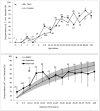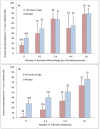High levels of human infection with Trypanosoma cruzi associated with the domestic density of infected vectors and hosts in a rural area of northeastern Argentina
- PMID: 30165892
- PMCID: PMC6118006
- DOI: 10.1186/s13071-018-3069-0
High levels of human infection with Trypanosoma cruzi associated with the domestic density of infected vectors and hosts in a rural area of northeastern Argentina
Abstract
Background: Insecticide spraying campaigns designed to suppress the principal vectors of the Chagas disease usually lack an active surveillance system that copes with house reinvasion. Following an insecticide campaign with no subsequent surveillance over a 12-year period, we implemented a longitudinal intervention programme including periodic surveys for Triatoma infestans, full-coverage house spraying with insecticides, and selective control in a well-defined rural area of the Argentinean Chaco inhabited by Creoles and one indigenous group (Qom). Here, we conducted a cross-sectional study and report the age-specific seroprevalence of human T. cruzi infection by group, and examine the association between human infection, the onset of the intervention, the relative density of infected domestic bugs, and the household number of infected people, dogs, or cats.
Results: The seroprevalence of infection among 691 residents examined was 39.8% and increased steadily with age, reaching 53-70% in those older than 20 years. The mean annual force of infection was 2.5 per 100 person-years (95% CI: 1.8-3.3%). Infection in children younger than 16 years born before the intervention programme was two to four times higher in houses with infected T. infestans than in houses without them and was six times higher when there were both infected dogs or cats and bugs than when they were absent. The model-averaged estimate of the intervention effect suggests that the odds of seropositivity were about nine times smaller for those born after the onset of the intervention than for those born before it, regardless of ethnic background, age, gender, household wealth, and cohabitation with T. cruzi-infected vectors or human hosts. Human infection was also closely associated with the baseline abundance of infected domestic triatomines and the number of infected cohabitants. Two of 43 children born after interventions were T. cruzi-seropositive; since their mothers were seropositive and both resided in apparently uninfested houses they were attributed to vertical transmission. Alternatively, these cases could be due to non-local vector-borne transmission.
Conclusions: Our study reveals high levels of human infection with T. cruzi in the Argentinean Chaco, and the immediate impact of sustained vector surveillance and selective control actions on transmission.
Keywords: Cats; Chagas disease; Dogs; Eco-epidemiology; Gran Chaco; Seroprevalence; Triatoma infestans.
Conflict of interest statement
Ethics approval and consent to participate
All research activities were conducted according to protocols approved by the Dr Carlos Barclay Independent Ethical Committee for Clinical Research from Buenos Aires, Argentina (Institutional Review Board No 001678, National Institutes of Health registered, protocol number TW-01-004). Animal care and use were performed according to guidelines issued by the Institutional Animal Care and Use Committee at the Faculty of Exact and Natural Sciences, which is based on the International Guiding Principles for Biomedical Research Involving Animals developed by the Council for International Organizations of Medical Sciences.
Consent for publication
Not applicable.
Competing interests
The authors declare that they have no competing interests.
Publisher’s Note
Springer Nature remains neutral with regard to jurisdictional claims in published maps and institutional affiliations.
Figures


Similar articles
-
Long-term impact of a ten-year intervention program on human and canine Trypanosoma cruzi infection in the Argentine Chaco.PLoS Negl Trop Dis. 2021 May 12;15(5):e0009389. doi: 10.1371/journal.pntd.0009389. eCollection 2021 May. PLoS Negl Trop Dis. 2021. PMID: 33979344 Free PMC article.
-
A prospective study of the effects of sustained vector surveillance following community-wide insecticide application on Trypanosoma cruzi infection of dogs and cats in rural Northwestern Argentina.Am J Trop Med Hyg. 2006 Oct;75(4):753-61. Am J Trop Med Hyg. 2006. PMID: 17038707 Free PMC article.
-
Impact of community-based vector control on house infestation and Trypanosoma cruzi infection in Triatoma infestans, dogs and cats in the Argentine Chaco.Acta Trop. 2007 Sep;103(3):201-11. doi: 10.1016/j.actatropica.2007.06.007. Epub 2007 Jun 27. Acta Trop. 2007. PMID: 17686448 Free PMC article.
-
Insecticide resistance in vector Chagas disease: evolution, mechanisms and management.Acta Trop. 2015 Sep;149:70-85. doi: 10.1016/j.actatropica.2015.05.014. Epub 2015 May 21. Acta Trop. 2015. PMID: 26003952 Review.
-
Considering Dogs as Complementary Targets of Chagas Disease Control.Vector Borne Zoonotic Dis. 2019 Feb;19(2):90-94. doi: 10.1089/vbz.2018.2325. Epub 2018 Aug 13. Vector Borne Zoonotic Dis. 2019. PMID: 30102585 Review.
Cited by
-
Insights from quantitative and mathematical modelling on the proposed WHO 2030 goals for Chagas disease.Gates Open Res. 2019 Sep 17;3:1539. doi: 10.12688/gatesopenres.13069.1. eCollection 2019. Gates Open Res. 2019. PMID: 31781687 Free PMC article.
-
The potential risk of enzootic Trypanosoma cruzi transmission inside four training and re-training military battalions (BITER) in Colombia.Parasit Vectors. 2021 Oct 9;14(1):519. doi: 10.1186/s13071-021-05018-4. Parasit Vectors. 2021. PMID: 34625109 Free PMC article.
-
Cultural perception of triatomine bugs and Chagas disease in Bolivia: a cross-sectional field study.Parasit Vectors. 2019 Jun 10;12(1):291. doi: 10.1186/s13071-019-3546-0. Parasit Vectors. 2019. PMID: 31182163 Free PMC article.
-
Long-term impact of a ten-year intervention program on human and canine Trypanosoma cruzi infection in the Argentine Chaco.PLoS Negl Trop Dis. 2021 May 12;15(5):e0009389. doi: 10.1371/journal.pntd.0009389. eCollection 2021 May. PLoS Negl Trop Dis. 2021. PMID: 33979344 Free PMC article.
-
Inequalities in the social determinants of health and Chagas disease transmission risk in indigenous and creole households in the Argentine Chaco.Parasit Vectors. 2019 Apr 27;12(1):184. doi: 10.1186/s13071-019-3444-5. Parasit Vectors. 2019. PMID: 31029147 Free PMC article.
References
-
- WHO Chagas disease in Latin America: an epidemiological update based on 2010 estimates. Wkly Epidemiol Rec. 2015;90:33–44. - PubMed
-
- Silveira A. O controle da doença de Chagas nos países do Cone Sul da América: história de uma iniciativa internacional 1991–2001. In: Silveira AC, editor. El control de la enfermedad de Chagas en los países del Cono Sur de América. Historia de una iniciativa internacional 1991/2001, vol. 2002. Buenos Aires: PAHO. p. 15–44.
MeSH terms
Substances
Grants and funding
- PICT 2014-2661/Fondo para la Investigación Científica y Tecnológica
- PIP No 11220110101146/Consejo Nacional de Investigaciones Científicas y Técnicas
- A70596/World Health Organization (CH)
- 20020100100944/Secretaria de Ciencia y Tecnica, Universidad de Buenos Aires
- 20020130100843BA/Secretaria de Ciencia y Tecnica, Universidad de Buenos Aires
LinkOut - more resources
Full Text Sources
Other Literature Sources
Medical
Miscellaneous

